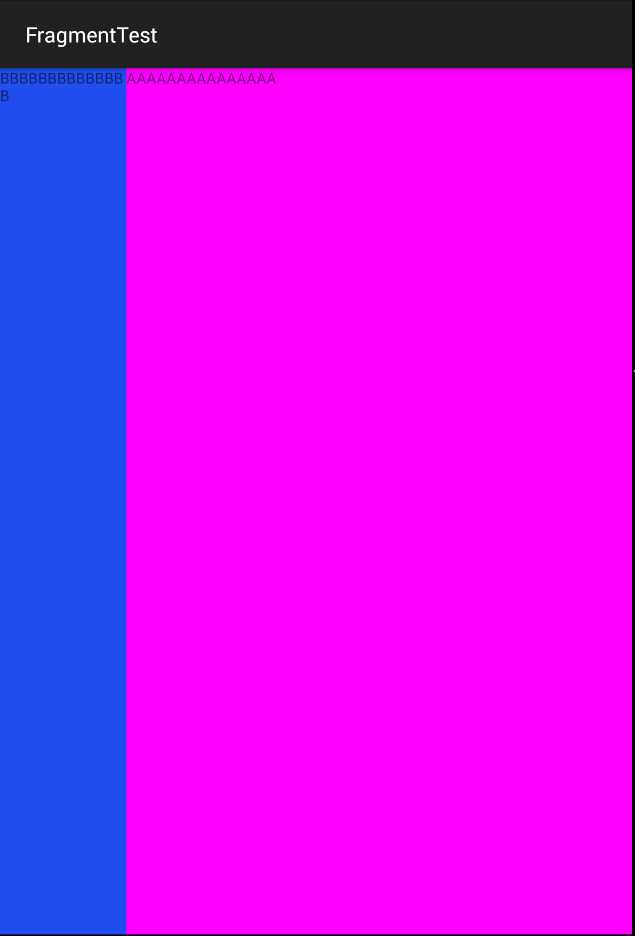标签:
通常我们使用Activity来展示界面,但是在手机上界面可能显示的很好看,但在平板上,因为平板的屏幕非常大,手机的界面放在平板上可能会出现控件被拉长、控件之间间距变大等问题。为了更好的体验效果,在Activity中嵌入“子Activity”,然后每个“子Activity”又可以拥有自己的布局,于是Fragment登场了。
Fragment是Activity界面中的一部分或一种行为,你可以把多个Fragment组合到一个Acvitity中来创建一个多面界面,并且你也可以在多个Activity中重用一个Fragment,你可以选择在Activity运行时候添加或者删除Fragment,它具有自己的生命周期,接受它自己的事件。
Fragment不能独立存在,它必须是嵌入到Activity中的,而且Fragment的生命周期受所在Activity的影响:Activity暂停,它所拥有的所有的Fragment都暂停,Activity销毁,它所拥有的所有Fragment都销毁。只有当Activity出于活动状态时,程序员才可以通过独立的方法操作Fragment。
Fragment的特性归纳如下:
创建Fragment和Activity非常相似,需要继承Fragment及其子类,于此同时,只要将原来卸载Acitivity回调方法的代码“移到”Fragment的回调方法中即可。
Fragment的创建分为动态和讲台两种
静态创建Fragment简单示例:
步骤很简单,创建两个LinearLayout布局文件fragment1和fragment2,分别放入两个TextView;创建两个继承Fragment的类Fragmeng1和Fragment2,分别加载刚才建好的布局文件并返回;在主Activity的布局文件里面加入两个Fragment的引用,使用android:name前缀来引用具体的Fragment:
fragment1.xml
<?xml version="1.0" encoding="utf-8"?> <LinearLayout xmlns:android="http://schemas.android.com/apk/res/android" android:layout_width="match_parent" android:layout_height="match_parent" android:orientation="vertical"> <TextView android:id="@+id/fragment1" android:layout_width="match_parent" android:layout_height="match_parent" android:background="#204eee" android:text="BBBBBBBBBBBBBB" /> </LinearLayout>
fragment2.xml
<?xml version="1.0" encoding="utf-8"?> <LinearLayout xmlns:android="http://schemas.android.com/apk/res/android" android:layout_width="match_parent" android:layout_height="match_parent" android:orientation="vertical"> <TextView android:id="@+id/fragment2" android:layout_width="match_parent" android:layout_height="match_parent" android:background="#ff00ff" android:text="AAAAAAAAAAAAAAA" /> </LinearLayout>
Fragment1.java
package cn.lixyz.fragmenttest; import android.app.Fragment; import android.os.Bundle; import android.support.annotation.Nullable; import android.view.LayoutInflater; import android.view.View; import android.view.ViewGroup; /** * Created by LGB on 2015/8/26. */ public class Fragment1 extends Fragment { @Nullable @Override public View onCreateView(LayoutInflater inflater, ViewGroup container, Bundle savedInstanceState) { View bookListView = inflater.inflate(R.layout.fragment1, container, false); return bookListView; } }
Fragment2.java
package cn.lixyz.fragmenttest; import android.app.Fragment; import android.os.Bundle; import android.support.annotation.Nullable; import android.view.LayoutInflater; import android.view.View; import android.view.ViewGroup; /** * Created by LGB on 2015/8/26. */ public class Fragment2 extends Fragment { @Nullable @Override public View onCreateView(LayoutInflater inflater, ViewGroup container, Bundle savedInstanceState) { View bookDescView = inflater.inflate(R.layout.fragment2, container, false); return bookDescView; } }
activity_layout.xml
<LinearLayout xmlns:android="http://schemas.android.com/apk/res/android" xmlns:tools="http://schemas.android.com/tools" android:layout_width="match_parent" android:layout_height="match_parent" tools:context=".MainActivity" android:orientation="horizontal"> <!-- 主Activity的布局文件,在里面加入两个Fragment的引用,使用android:name前缀来引用具体的Fragment --> <fragment android:id="@+id/book_list" android:name="cn.lixyz.fragmenttest.Fragment1" android:layout_width="match_parent" android:layout_height="match_parent" android:layout_weight="4" /> <fragment android:id="@+id/book_desc" android:name="cn.lixyz.fragmenttest.Fragment2" android:layout_width="match_parent" android:layout_height="match_parent" android:layout_weight="1" /> </LinearLayout>
MainActivity.java
package cn.lixyz.fragmenttest; import android.support.v7.app.AppCompatActivity; import android.os.Bundle; import android.view.Menu; import android.view.MenuItem; public class MainActivity extends AppCompatActivity { @Override protected void onCreate(Bundle savedInstanceState) { super.onCreate(savedInstanceState); setContentView(R.layout.activity_main); } }
AndroidManiFest.xml
<?xml version="1.0" encoding="utf-8"?> <manifest xmlns:android="http://schemas.android.com/apk/res/android" package="cn.lixyz.fragmenttest" > <application android:allowBackup="true" android:icon="@mipmap/ic_launcher" android:label="@string/app_name" android:theme="@style/AppTheme" > <activity android:name=".MainActivity" android:label="@string/app_name" > <intent-filter> <action android:name="android.intent.action.MAIN" /> <category android:name="android.intent.category.LAUNCHER" /> </intent-filter> </activity> </application> </manifest>
运行结果:

Android笔记(十九) Android中的Fragment
标签:
原文地址:http://www.cnblogs.com/xs104/p/4759127.html